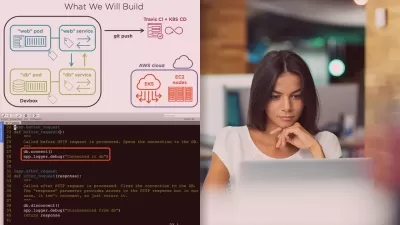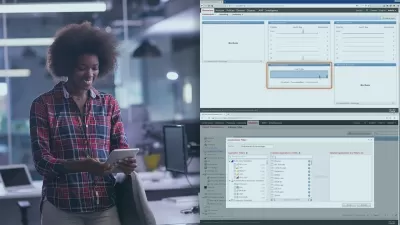CISCO OSPF Hands-on Certification Training
EDUCBA Bridging the Gap
10:27:18
Description
Learn routing protocols from scratch and learn how to configure and use Open Shortest Path First (OSPF) effectively
What You'll Learn?
- The primary skill that this OSPF certification course claims to teach is related to the routing and networking protocols based skillset
- This also ensures that the infrastructure resources and configurations are also targeted as they form the primary component of the OSPF Routing course.
- The curriculum is designed in such a way that you will also feel yourself getting trained and gaining information about the OSPF Routing Certification.
- You can see your career path going in the direction of a network engineer and network administrator.
Who is this for?
What You Need to Know?
More details
DescriptionThis dynamic routing course is the one which explains in details about the various Routing protocol which are present in the OSPF routing. It talks and explains the networking basics which is much more helpful for the beginners who are new to the world and domain of networking. This OSPF Certification course of Routing Protocol OSPF builds a strong foundation for them to prepare for good level certifications like CCNA. You will be able to learn all the terminologies and key functionalities related to routing protocols. There is n number of routing protocols that are developed today but only very few have been adopted by the industry. In this course, all those concepts will be explained in detail and you can practice them at your ease. The broad areas to be covered are related to configurations, operations, and troubleshooting. Apart from that, there are a few use cases of two very popular Routing protocols that work on the principle of OSPF and have their level of advantages. This OSPF Certification Module describes how to connect and configure and operate Open Shortest Path First which was specifically designed for IP networks and therefore supports IP tagging and sub-netting of extremely derived information related to routing. It also allows the packet-based information and authentication to take place and also makes use of the multicast for Internet protocol when either sending or receiving any packet
This course module named Routing Protocols RIP and EIGRP is quite similar to the one used above and is also responsible to teach you many basics and fundamental concepts such as those related to troubleshooting, operation, and configuration. The two most important routing protocols which will be explained in detail are the RIP also known as Routing information protocol and the other is EIGRP which is the abbreviated form for Extended interior Gateway protocol. In the RIP protocol, the oldest of the vectors for distance IP Routing protocols are still put to use and thereby getting various enhancements. There are currently two versions that exist for the RIP viz. RIPv1 and RIPv2. RIPv1 is also said to be the classful protocol which means that it is not classless whereas if you talk about the RIPv2, it is considered to be the classless support routing protocol and IPv6 is the one whose support is extended to RIPv2 with the next-gen RIP which is also termed as RIPng. EIGRP, on the other hand, is related to the Interior Gateway protocol as it is a proprietary protocol of the company CISCO. This protocol is occasionally described as the distance vector routing protocol which also acts and imitates like a link state-oriented protocol. Distance vector-based protocols share everything of which they are aware of. The only limitation they carry is that the amount of information shared is only among the neighbors which are directly or indirectly connected with each other. Link state-based protocols announce that the information present is only about the direction and not indirectly connected links. However, they are also responsible to share the routing protocol information among themselves in all the areas they deem fit among all the routes in their domain or area.
Who this course is for:
- The target audience for this course is anybody who has a keen interest in the field of digital communication and is also aware of how the basics of understanding the networks and other routing protocols and mechanisms such as OSPF Routing. This classifies all the professionals such as network administrators, engineers, administrators, Linux engineers, Tier-1 and tier-2 support team, communication engineer, digital and analog communication and networking engineer, etc.
This dynamic routing course is the one which explains in details about the various Routing protocol which are present in the OSPF routing. It talks and explains the networking basics which is much more helpful for the beginners who are new to the world and domain of networking. This OSPF Certification course of Routing Protocol OSPF builds a strong foundation for them to prepare for good level certifications like CCNA. You will be able to learn all the terminologies and key functionalities related to routing protocols. There is n number of routing protocols that are developed today but only very few have been adopted by the industry. In this course, all those concepts will be explained in detail and you can practice them at your ease. The broad areas to be covered are related to configurations, operations, and troubleshooting. Apart from that, there are a few use cases of two very popular Routing protocols that work on the principle of OSPF and have their level of advantages. This OSPF Certification Module describes how to connect and configure and operate Open Shortest Path First which was specifically designed for IP networks and therefore supports IP tagging and sub-netting of extremely derived information related to routing. It also allows the packet-based information and authentication to take place and also makes use of the multicast for Internet protocol when either sending or receiving any packet
This course module named Routing Protocols RIP and EIGRP is quite similar to the one used above and is also responsible to teach you many basics and fundamental concepts such as those related to troubleshooting, operation, and configuration. The two most important routing protocols which will be explained in detail are the RIP also known as Routing information protocol and the other is EIGRP which is the abbreviated form for Extended interior Gateway protocol. In the RIP protocol, the oldest of the vectors for distance IP Routing protocols are still put to use and thereby getting various enhancements. There are currently two versions that exist for the RIP viz. RIPv1 and RIPv2. RIPv1 is also said to be the classful protocol which means that it is not classless whereas if you talk about the RIPv2, it is considered to be the classless support routing protocol and IPv6 is the one whose support is extended to RIPv2 with the next-gen RIP which is also termed as RIPng. EIGRP, on the other hand, is related to the Interior Gateway protocol as it is a proprietary protocol of the company CISCO. This protocol is occasionally described as the distance vector routing protocol which also acts and imitates like a link state-oriented protocol. Distance vector-based protocols share everything of which they are aware of. The only limitation they carry is that the amount of information shared is only among the neighbors which are directly or indirectly connected with each other. Link state-based protocols announce that the information present is only about the direction and not indirectly connected links. However, they are also responsible to share the routing protocol information among themselves in all the areas they deem fit among all the routes in their domain or area.
Who this course is for:
- The target audience for this course is anybody who has a keen interest in the field of digital communication and is also aware of how the basics of understanding the networks and other routing protocols and mechanisms such as OSPF Routing. This classifies all the professionals such as network administrators, engineers, administrators, Linux engineers, Tier-1 and tier-2 support team, communication engineer, digital and analog communication and networking engineer, etc.
User Reviews
Rating
EDUCBA Bridging the Gap
Instructor's Courses
Udemy
View courses Udemy- language english
- Training sessions 80
- duration 10:27:18
- Release Date 2022/11/22











